How to Fix a Leaky Shower Faucet – A No-Nonsense Guide!

Leaky Shower Faucet
Learning how to fix a leaky shower faucet the right way will save you loads of time and money. Leaks can be devastating when left unchecked. They waste water and leave impossible-to-clean stains.
If the leak is from the hot water tap for How to Fix a Leaky Shower Faucet, you’ll end up paying far more for usual for your electric bill as the water heater has to compensate for the leak.
When your faucet is leaking in the wall, it can damage electric cables, cause mold and even cause structural damage. It’s clear how important it is to fix any leaks as quickly and safely as you can that How to Fix a Leaky Shower Faucet. Our guide will cover this in detail and go over a couple of different faucet types – and how to fix them when they leak.
Let’s get into the guide.
How to Fix a Leaky Shower Faucet
We’ll cover the steps you should follow for each of the most common faucet types. I’ve researched so that you don’t have to, and I’ve kept the steps as simple and foolproof as possible.
Make sure that you stick to the order and have the right tools. Using the wrong tools can do more damage, and make it even harder to do future fixes.
What Causes a Shower Faucet to Leak?
There could be many reasons for this, but for the sake of simplicity, it’s usually due to worn out rubber seals. These are the O-shaped rubber bands that close up the spaces where water can leak out.
Over time, they’re exposed to wearing and being broken down, so they need to be replaced. The good news is that this is relatively easy to do, and doesn’t require you to call in a costly plumber.
Here Are Some Tips before Getting Started
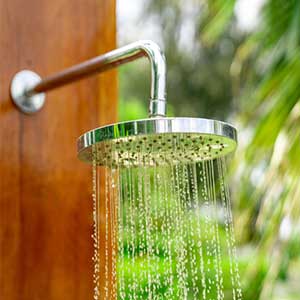 Here Are a Couple of Things You’Re Going to Want to Do before Doing Any Fixing:
Here Are a Couple of Things You’Re Going to Want to Do before Doing Any Fixing:
- Get a good cloth without any holes – place this cloth over the drain or plug to stop any falling nuts, bolts or O-rings from going down the drain
- Shut off your water supply – you might think this is a little too obvious, but I’ve even forgotten to do this and ended up looking like I’ve just got out the swimming pool
- Let the water in the pipes and showerhead all run out before starting the fix, otherwise, you might get an unpleasant surprise when you turn the tap on
Keep these in mind as you go through the steps for fixing each of the faucet types.
How to Fix a Leaky Shower Faucet Single Handle
These are very common, and it’s the type that I have in my bathroom.
Here are the steps that you need to follow. Before you get started, remember to cover the drain or plug hole with the cloth, and to drain the water from the system (after shutting off the water supply).
Once you’ve done that you can move on to fixing the faucet. Here are the steps you should follow.
Step 1: Get the Tools You’ll Need
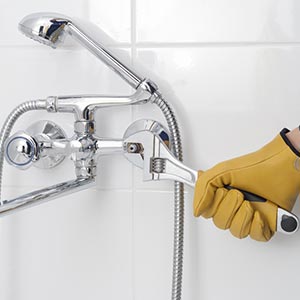 Make Sure You Have the Following Tools Readily Available:
Make Sure You Have the Following Tools Readily Available:
- Flatbed screwdriver
- Philips screwdriver
- Socket wrench (deep-welled) or a cartridge puller
- Needle nose pliers
Keep these next to you and make sure they can’t fall into the drain.
Step 2: Remove the Faucet Handle
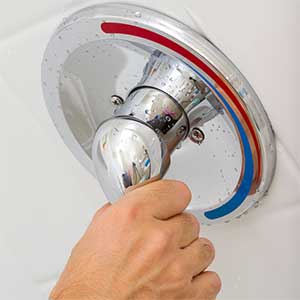
To complete this step, you’ll need to find the screw holding the handle on.
Sometimes there is a removable plate or cap over where the screw is housed.
You can pop the plate or cap out easily by using the flathead screwdriver and remove the screws with the relevant Philips screwdriver.
Make sure you put the screw somewhere where they can’t roll away or slip into the drain.
Step 3: Remove the Faceplate
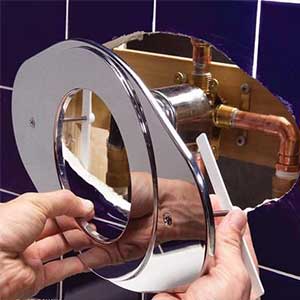 Once you’ve removed the handle, you’ll need to take off the faceplate. This is used to cover up the hole in the wall and needs to be removed for you to get access to the pipes behind it.
Once you’ve removed the handle, you’ll need to take off the faceplate. This is used to cover up the hole in the wall and needs to be removed for you to get access to the pipes behind it.
There will be at least 2 screws that need to be removed. Use the appropriate Philips screwdriver to take these screws out and keep them separate (don’t get them mixed up with the screw for the handle).
Use your hands to wiggle the plate free and remove it from the wall. Don’t use too much force or you could damage the wall or the pipes behind.
Step 4: Take Off the Escutcheon
This is the sleeve that covers the shower valve. You can often remove it by sliding it off, or by unscrewing it.
You should be able to do this by hand. If there is a lot of mineral build-up that’s stopping it from coming off easily, just pour some warm water and vinegar over it.
Wipe away the residue with a cloth, and then try again.
Step 5: Remove the Locking Clip
Not all shower valves have these. You can locate it by looking for a U-shaped clip sticking out the top of the pipe. You’ll need to use the long-nosed pliers or the flatbed screwdriver to release the clip and get access to the valve.
Make sure to put the clip somewhere safe.
Step 6: Loosen and Remove the Regulating Cartridge
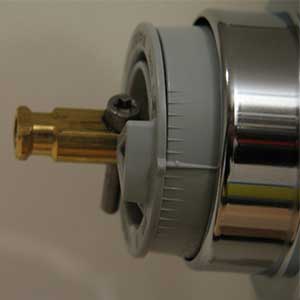 This cartridge regulates the flow and temperature of the water.
This cartridge regulates the flow and temperature of the water.
It has a cylindrical shape and there’s a small bit of metal sticking out at the end.
Use the socket wrench and fit it over the end bit, and loosen the cartridge.
Remove the cartridge with the pliers (it might also come out with the wrench).
Step 7: Install the New Cartridge
If you don’t know the make and model, just take the cartridge you removed to the store and get an exact replacement.
Insert the cartridge into its place and use the socket wrench to tighten it in a clockwise direction. Be sure not to make it too tight, or you risk damaging the cartridge.
Step 8: Put the Faucet Together Again
You just need to reverse the removal steps to install the relevant parts again.
Make sure you use the right screws and try your best not to strip the heads of the screws, or you’ll struggle to get them off in the future.
You might also want to consider soaking the different parts of the faucet in a warm water and vinegar mix if they have any lime or mineral build-up on them. Do this before reassembling the faucet.
Step 9: Test the Faucet
Turn on the water supply and give the water a minute to fill the pipes again. There might be an airburst at first, so be ready for that.
If the leak hasn’t been fixed by following these steps, you need to call in a professional to handle it for you.
How to Fix a Leaking Shower Faucet Delta
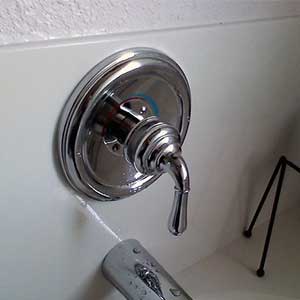 Since we have already covered the steps you need to follow to fix most shower faucets, there’s no need to repeat them here.
Since we have already covered the steps you need to follow to fix most shower faucets, there’s no need to repeat them here.
The good news is that you simply need to follow the same steps to fix Delta shower faucets.
There Are a Couple of Things that You Need to Keep in Mind:
- Get the official Delta replacement cartridge
- Two screws need to be removed when taking off the faucet handle
- The stop tube or sleeve slides off, it’s not screw-off
- The cartridge goes on the hot side (usually the left side)
- Use tub chalk to seal the escutcheon to the wall
These pointers should be used along with the “How to fix a leaky shower faucet” steps from the above section. Be sure to have the right tools nearby, use a cloth to block the drain and keep all the screws separate from each other.
You should also clean the individual parts of the faucet to make sure they’re free of any build-up.
P.S. The steps will also work if you want to know how to fix a leaky shower faucet single handle delta. Just follow the steps and keep these tips in mind.
How to Fix a Leaky 3 Handle Shower Faucet
The same steps will also work with fixing 3 handle shower faucets. You need to check to see if your taps have individual shutoff valves. If they do, then you need to shut each of them off, one at a time, to see which tap is responsible for the leak.
This will save you from having to remove and fix all 3 taps. If you’re in doubt, then go ahead and fix all 3. If you’re having trouble removing any of the screw-on parts, get some lubrication spray to help them loosen more easily.
- Best Shower Faucets (Reviews + Buying Guide)
Final Thoughts
That’s it for the guide. Well done for taking the time and initiative to fix your leaky shower faucet. If you followed all the steps and still couldn’t fix the leaks, then you need to call a plumber. There’s no use in you hashing around in the wall – you might even make matters worse.
Now that you know how to fix a leaky shower faucet, it’s time to put what you’ve learned into practice – you’ll be fixing leaks in no time!




